Order Items From Most General To Most Specific
Subject: Language arts
Grade: Fifth grade
Topic: Organizing Writing
Please LOG IN to download the presentation. Access is available to registered users only.
View More Content
Organizing Writing: From General to Specific
– Importance of organization
– Good organization makes writing clear and understandable.
– Ordering ideas: general to specific
– Start with broad ideas, then give details.
– Preview of today’s lesson
– We’ll learn how to structure writing effectively.
– Engaging activities planned
|
This slide introduces the concept of organizing writing by ordering ideas from the most general to the most specific. Emphasize to students that good organization is key to making their writing clear and easy to follow. Explain that starting with a broad idea gives the reader a foundation, which is then built upon with more specific details. Today’s lesson will cover techniques for structuring their writing, and the class will participate in activities to practice these skills. Activities may include sorting sentences from general to specific, creating outlines for a given topic, or rewriting paragraphs to improve their organization.
The Role of Organization in Writing
– Organization: Writing’s roadmap
– Just like a map guides a traveler, organization guides the reader.
– Guides readers through your thoughts
– Clear organization helps readers understand the sequence and flow.
– Enhances writing effectiveness
– Well-organized writing is persuasive and impactful.
– Key to clear communication
– Organized ideas make the message easy to grasp and remember.
|
This slide introduces the concept of organization in writing to fifth-grade students. Explain that organization in writing is similar to a roadmap that helps guide the reader through the text, making it easier to follow and understand the writer’s thoughts. Emphasize that good organization is not just about neatness; it’s about making the writing more effective and impactful. Use examples like a well-organized room versus a messy one to illustrate the importance of organization. Encourage students to think about how they can organize their own writing in a way that makes sense and is easy for others to follow.
From General to Specific: Organizing Ideas
– Understand general information
– General info introduces a topic broadly, like ‘animals’.
– Grasp specific information
– Specific info gives details, like ‘the diet of a panda’.
– Use the funnel writing approach
– Start with broad ideas, narrow down to detailed points.
– Why organization matters
|
This slide aims to teach students how to structure their writing by starting with general information and gradually moving to more specific details, similar to how a funnel narrows down. General information sets the stage and gives readers an idea of the topic at hand, while specific information provides depth and evidence. The funnel approach is a useful tool for organizing thoughts and ensuring that writing flows logically from broad concepts to focused arguments or descriptions. Encourage students to practice this method by picking a broad topic and then writing down increasingly specific ideas related to it. Discuss why good organization is crucial for clear communication and how it helps readers understand the writer’s main points.
The Power of Starting General
– Begin with broad ideas
– Introduce the topic to the reader
– Context for upcoming details
– Give background, make connections
– Stage-setting for specifics
– Prepare readers for deeper info
– Why general before specific?
|
This slide aims to explain the importance of starting with general ideas when organizing writing. Beginning with broad concepts helps to introduce the reader to the topic without overwhelming them with too much detail. It provides a foundation and context for the more specific information that will follow, allowing the reader to make connections and understand the relevance of the details. By setting the stage with general ideas, writers can build interest and guide their audience through their writing in a structured and comprehensible way. Encourage students to think of writing as a journey where they lead their readers from the known to the unknown, using general ideas as the starting point.
Moving to Specifics in Writing
– Start with a broad topic
– Add details to narrow down
– Details zoom in on the subject, like using a magnifying glass
– Use examples to clarify
– For instance, instead of ‘vehicles’, say ‘red bicycles with baskets’
– Specifics enhance interest
– Specific facts or descriptions make your story unique and vivid
|
This slide aims to teach students how to refine their writing by starting with a general topic and gradually adding specific details to make it more engaging. Begin by explaining the concept of starting broad, akin to an overview or introduction. Then, show how to add layers of detail to focus the topic more narrowly, which helps the reader understand the subject better. Use relatable examples to illustrate how general statements can be made more specific and clear. Emphasize that specificity in writing helps to capture the reader’s interest and convey information more effectively. Encourage students to practice by taking a general topic and adding specific details to make their writing more descriptive and informative.
Using Examples in Writing
– Examples illuminate ideas
– They act like a light, making your ideas clear and understandable.
– Examples support points
– Think of examples as proof that what you’re saying is true.
– Examples make writing convincing
– Good examples can persuade readers to agree with your argument.
|
This slide aims to teach students the importance of using examples in their writing to clarify, support, and persuade. Begin by explaining how examples work to shed light on general ideas, making them easier for the reader to understand. Then, discuss how examples serve as evidence that bolsters the writer’s points. Finally, illustrate how examples can make arguments more convincing, swaying the reader to the writer’s perspective. Encourage students to think of their own examples related to a topic they enjoy, and consider how these examples help to explain their thoughts more clearly.
Class Activity: Organizing Ideas
– Begin with a broad topic sentence
– Add a specific detail sentence
– This sentence narrows down the topic
– Include an example sentence
– For instance, if our topic is ‘pets’, an example could be ‘Dogs can be great companions.’
– Conclude with a final specific detail
– Another detail could describe types of dogs
|
This activity is designed to help students understand how to structure a paragraph, starting with a general statement and becoming more specific. Begin by discussing what a topic sentence is and how it introduces the main idea. Then, guide students to add sentences with more specific details, followed by an example that illustrates their point. Finally, have them add another detail to support the topic. This exercise will be done as a group to encourage collaboration. Possible topics could be ‘seasons’, ‘hobbies’, or ‘school subjects’. Each student can contribute a sentence, and together they will build a well-organized paragraph.
Let’s Practice: Organizing Ideas
– Start with a broad topic
– Write a general statement
– Think of an umbrella statement
– Add three specific supporting sentences
– Details that explain or describe the general statement
– Organize from general to specific
– Arrange sentences to flow logically
|
This slide is for an individual activity aimed at teaching students how to structure their writing by starting with a general statement and then providing specific supporting details. Students should choose a topic they are interested in and write one general statement about it. Then, they should write three specific sentences that support this statement. The goal is to practice organizing thoughts in a logical manner, beginning with a broad concept and then narrowing down to particular details. This exercise will help students understand the importance of structure in writing and how to effectively communicate their ideas. In the next class, students can share their sentences and discuss the process of organizing their thoughts.
Sharing Our Writing: Organizing Ideas
– Volunteers share their paragraphs
– Discuss effective organization
– What makes the flow logical and easy to understand?
– Provide constructive feedback
– Highlight what’s done well, be kind and helpful
– Suggestions for better structure
– How can we order ideas from general to specific?
|
This slide is for a class activity where students will volunteer to read their written paragraphs aloud. The class will then engage in a discussion about the effectiveness of the organization within each paragraph. Emphasize the importance of ordering ideas from most general to most specific to create a logical flow that’s easy to follow. Encourage students to provide feedback that is both positive and constructive, focusing on how their peers can improve the structure of their writing. As a teacher, facilitate the discussion to ensure it remains respectful and productive, and offer your own suggestions to help students understand how to better organize their writing.
Conclusion & Homework: Structuring Ideas
– Recap: Order from general to specific
– Why organization matters in writing
– Clear writing helps readers understand better
– Homework: Write a structured essay
– Choose a topic and apply what you’ve learned
– Use the general to specific guideline
– Start with a broad idea, then include details
|
As we conclude, remind students of the importance of organizing their writing by starting with the most general ideas and gradually moving to more specific details. This structure helps in creating a clear and logical flow that readers can easily follow. For homework, students are to write a short essay on a topic provided by the teacher. They should practice using the general to specific structure, beginning their essay with a broad statement or idea and then narrowing down to more detailed points. This exercise will reinforce their understanding of the concept and improve their writing skills. Provide a rubric for the essay to guide them on how to structure their paragraphs effectively.






